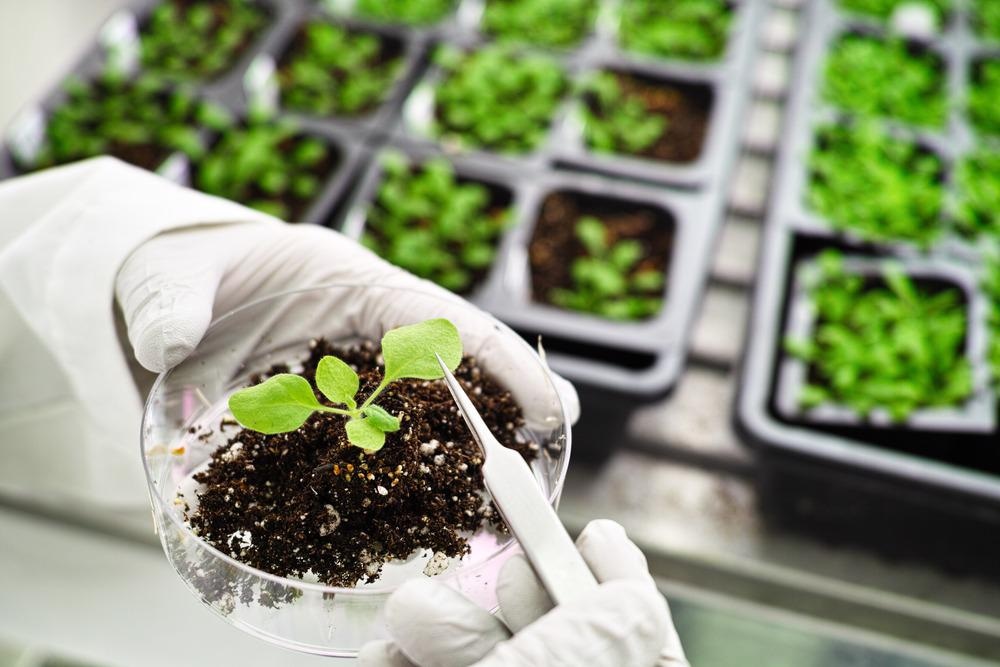A group of researchers investigated the potential genetic effects on the model organism Arabidopsis thaliana when exposed to engineered nanomaterials, and published their findings in the journal ACS Nano. In Murashige-Skoog (MS) synthetic growth media, CeO2, CdS QDs, FeOx, ZnS, and related soluble compounds were used at concentrations ranging (100–500 mg) and exposition durations (1–20 d).

Study: Engineered Nanomaterial Exposure Affects Organelle Genetic Material Replication in Arabidopsis thaliana. Image Credit: SINITAR/Shutterstock.com
Interactions with nanoscale CeO2 and FeOx generates an 80-100 percent rise in biomass, but ZnS and CdS QDs result in stable or 50 percent growth, respectively.
The stoichiometry of ptDNA and mtDNA was not affected by nanoscale CeO2 irradiation, indicating that stoichiometry alteration is a possible morpho-functional adaptation strategy to engineered nanomaterial (ENM) exposure, caused by changes in cellular energy balance, which reduces vegetation or cellular respiratory rate.
Importance of Creating Exposure Biomarkers
A broad variety of engineered nanomaterials of various types have experienced increased usage in commercial processes, industrial and pharmaceutical goods, and farming during the last decade. This trend is expected to continue to rise.
Considerations about environmental outcomes and impacts of these compounds have prompted research into predicting ecological emissions in the atmosphere, ocean, and soil, as well as attempts to establish potential ecological utilization for land and aquatic biodiversity.
As a result, developing exposure indicators to the many kinds of nanoparticles that are possibly aggregating in the environment is critical.
The characteristics of ENM usage and release may make these evaluations more challenging.
ENMs in farming, for example, might occur intentionally to obtain advantages following absorption by plant leaves and roots, but they can also happen accidentally via aerial precipitation or inclusion in field applied biogas.
Analyzing the Effects of Nanomaterials on Plants
In recent years, significant literature has emerged examining plant reactions with ENMs from both an implementation and implication standpoint, with the plastid and chloroplasts emerging as prominent targets of ENM reaction.
Symbionts processes in which photosynthetic bacteria and proteobacteria-like microorganisms were fully incorporated with their parent bacterial species are hypothesized to have given rise to plastids and mitochondria.
Unlike mitochondria, which are assumed to have developed via single endosymbiotic activities, plastids are believed to have developed through numerous endosymbiotic events.
Even though many genes have transferred from subcellular DNA to the "host" nuclei during evolution, both plastids and mitochondria have their DNA with unique architecture, structure, and composition.
As mitochondria and chloroplasts rely on rapidly evolving oxidation-reduction (RedOx) reactions to sustain their metabolism efficiency, their chromosomes may be especially vulnerable to genetic damage caused by increased reactive oxygen species generation (ROS).
Considerable Danger of ENM Exposure to Plants
A variety of ENMs poses a considerable danger of plant material contamination.
For instance, the impacts of nanoscale CeO2 as a possible nano-fertilizer have been studied, with results varying depending on plant type and dosage.
These activities have resulted in the identification of CeO2 ENMs in the environment on regularly cultivated soil serving as the primary source.
A variety of organizations have looked into the effects of nanoscale Fe2O3 and Fe3O4 on plants, with ranging outcomes recorded and the long-term impact typically dependent on the EMN form used, decreased chlorophyll synthesis, and enhanced root elongation.
Possible Genetic Impacts of Nanomaterials
The current research investigated the genomic consequences of several manufactured nanomaterials at various dosages and contact durations.
Significantly, structural stability and quantity of organelle genetic information were assessed as end goals in both mitochondrial DNA and plastid DNA.
Initial experiments were intended to evaluate the reactions of mutated Arabidopsis thaliana to CdS QDs and the associated metal salt at various exposure durations and doses.
Researchers then set out to investigate how plants responded to CdS QDs vs other ENMs, aiming to reveal the importance of organelle engagement in ENM reaction and illustrate the significant potential of mtDNA and mtDNA as biological markers of exposure.
Research Findings and Conclusion
The research's main observation is that when organellar DNA molecules are exposed to certain nanomaterials, their copy number may fluctuate dramatically.
The activities of nucleic acids may or may not be linked to extreme biological effects on plants.
CeO2 nanomaterials had little effect on organelle activity, although they did increase ROS detoxification in the plant cell.
Fe-based interventions reduced mitochondrial and chloroplast functioning while increasing the number of copies of ptDNA and mtDNA.
The reactions of CdS QDs and ZnS QDs were comparable to those found with the salt forms.
Differential metal availability from salt or nanoscale forms, intrinsic metallic toxicity, and biocatalytic mechanisms that affect the material in the plant may all play a role in these size-specific alterations.
CdS QDs and CdSO4 have the most ability to change ptDNA and mtDNA copy counts, whereas CeO2 NPs did not affect organellar DNAs.
Continue reading: Nanotoxicology and Particle Toxicology
Reference
Luca Pagano. et al. (2022). Engineered Nanomaterial Exposure Affects Organelle Genetic Material Replication in Arabidopsis Thaliana. ACS Nano. Available at: https://pubs.acs.org/doi/10.1021/acsnano.1c08367
Disclaimer: The views expressed here are those of the author expressed in their private capacity and do not necessarily represent the views of AZoM.com Limited T/A AZoNetwork the owner and operator of this website. This disclaimer forms part of the Terms and conditions of use of this website.